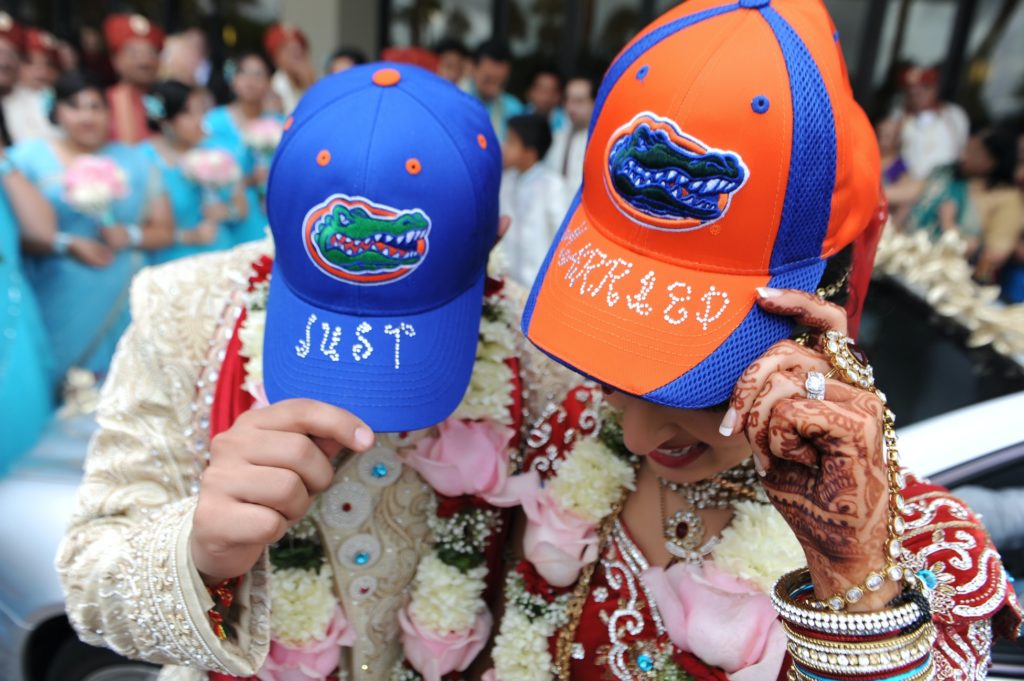As a photographer, you’ll be hard pressed to think of an event where people are more consistently happy and carefree than they are at weddings.

When you’re a wedding photographer, your role is almost as important as the minister, rabbi – or captain of the ship, if you happen to be at sea. The couple is counting on you to preserve this occasion so they can go back through their photo albums and digital scrapbooks for years to come, reliving all those special moments from their wedding day.
You’ll need energy, exuberance, patience and sometimes the people skills of an international diplomat to ensure everyone cooperates for the sake of the newlyweds and their photographs. Do this consistently – and with the eye of an artist – and you’ll enjoy an income that is traditionally among the highest in all fields of photography. Six figures a year is pretty much standard for the average wedding photographer. For the above-average photographer, your earnings potential is whatever you want it to be.
Wedding photography is big business and pays serious money. Read on to learn how you can get started in the lucrative field of wedding photography.
In this article you’ll learn:
- How much money you can make as a wedding photographer
- The required training and certifications
- Professional groups to join
- Employment opportunities for wedding photographers
- Finding clients
- Plus helpful tips
How much money can you make?
Wedding photographers do very well. The average salary is more than $104,000 per year, according to a recent ZipRecruiter survey of professionals in the field. The top 10 percent of wedding photographers earn $127,500 a year, on average. One of the additional financial benefits of this photography specialty is most wedding ceremonies are conducted on weekends, which means you can pursue other work during the week.

Training and Certification
Depending on where you live, chances are there are absolutely no regulations or licensing requirements for a wedding photographer. You’ll need a business license, which you can arrange by calling your local government offices.
Even though formal certification is not a legal requirement to photograph weddings, being able to show potential clients that you are trained and have credentials can go a long way toward securing steady work.

A simple Internet search will turn up many training courses for wedding photography, many for under $100. Here’s one example. When choosing a course, look for training programs that come with a certificate of completion once you finish. These certificates can typically be customized with your name, downloaded and printed, then framed for you to hang in your office. You’ll also want to make note of these credentials on your business website. People notice certifications, which show you are serious about your work. That makes customers more confident when choosing your photography services over competitors.
Along with training and certification, you’ll need a portfolio of excellent images to post on your website and to print on brochures when you meet with clients. This may seem like a daunting task when you’re just starting out. How do you get new clients for your wedding photography business if you’ve never photographed a wedding? It’s a fair question. One possibility is to offer your service for free or at minimal cost to a friend who’s getting married, with the understanding that the pictures will be used in your marketing materials. You can give your friend a nicely bound photograph album of the pictures as a thank-you gift. Even if you know a couple who’ve already hired a photographer for their wedding, maybe they will let you take pictures as well. Understand that as a beginner you may not be able to charge $5,000 or $10,000 to shoot a wedding if you don’t have the experience and portfolio to justify premium pricing. In that case, marketing your services to couples on a budget might be the best way to go.
In time and with practice, you’ll build a portfolio that will be the envy of the industry and you can charge as much as the market will bear.
Professional Groups to Join
There are many professional photographers’ organizations you can join to network with other pros and advance your photography career. Here are some of the most relevant to wedding photographers:

The International Society of Professional Wedding Photographers is the largest organization devoted to this specialized field of photography. To be accepted, a photographer must submit a portfolio for review, agree to operate under the ISPWP Code of Conduct, and have an ISPWP sponsor or two references. And then the applicant must be voted in by current members. Annual dues are $99 during the COVID-19 pandemic (regularly $179 a year). Member benefits include:
- $200 Value in Contest Entry Fees
- Up to five location directory listings (helps clients find you)
- Access to SEO-optimized ISPWP blog to publish
- Daily promotion on ISPWP social media
- Live Interviews, online conferences, vendor discounts and more.
Professional Photographers of America is the premiere organization of photography pros in the United States. A full membership is open to anyone living in the United States or its territories and costs $323 per year. Benefits include:
- $15,000 equipment insurance policy
- Data loss protection
- Access to all online education courses
- Online referral database listing
- Printed and digital monthly issues of Professional Photographer magazine
- One full registration to Imaging USA during the first year of membership
- Business Resources
- Contracts and Copyright Resources
- Access to Member Discount Program
- Weekly newsletter

American Photographic Artists
Benefits include a photographer photo ID card, discounts on Apple electronics, a listing in the association’s directory to help new clients find you, and more. Membership tiers range from $50 to $500 per year.
Employment
Contact wedding planners, bridal shops, formalwear shops, and even bakeries where people order wedding cakes. Send them your marketing materials, brochures and business cards. Follow up with a phone call in a day or two.
Use the networking power of your professional memberships to find assignments.
Depending on your budget, you can also sign up for online listing services. Sites like WeddingPro and TheKnot maintain directories of wedding service providers, including photographers, so consumers can find you by searching state and city listings. Shop around and do your own research on the sites where it makes the most sense to advertise, if you choose this route. Some of these sites charge several hundred dollars a month for listings, so you’ll need to be established and have a steady cash flow.
Finding Clients
Business cards and a basic website should be the core of your marketing toolkit as a wedding photographer. The website need not be fancy or expensive, just attractively designed, with photos of your best wildlife photography work, your business location and contact information. No need to include your pricing. You can discuss that directly with clients.
In addition to your business website, the next thing to do is create an Instagram account to showcase your photography. Instagram is the #1 online venue for creative professionals to display their work. It’s a free promotional tool that’s always working on your behalf.

Other strategies for attracting new business:
- Create a referral program with discounts for returning customers who bring new clients to you.
- Ask clients to review your services online. According to a recent survey, 90% of people say their buying decisions are influenced by positive online reviews.
Good to know
Use this handy checklist compiled by professional wedding photographers to avoid making the mistakes it took them years to overcome.

Get a liability insurance policy.
And keep it up to date. You may also want to have an attorney set up your operation as an LLC (Limited Liability Company). This affords you many legal protections in the event of disputes.
Use contracts.
Here is a guide to creating your own wedding photography contract template that you can download and print. Review it with an attorney who is experienced in contract law and small business operations to ensure you haven’t overlooked anything. A contract protects both you and the couple hiring you to photograph their wedding. Don’t perform work without a signed contract. You’ll also want to secure a deposit from the clients in advance of the wedding day. Many photographers stipulate the deposit is non-refundable. This protects the value of your time. Say, for example, that you book a Saturday afternoon and evening for a wedding, which could well consume 6 or more hours of your time, only to have the couple cancel on you. Then you’ve lost a weekend of work and will not likely find another client to fill that slot with short notice.
Get to know the couple.
You’ll need to have a sit-down meeting with every client to go over their needs, determine a price and sign the contract. A follow-up meeting or at least a phone call or two will help you get an even better sense of their personalities and answer any follow-up questions they might have. This shows you care, that you are interested in them and in making their special day the best it can be through your role as photographer.
Make a shot list.
Knowing the coverage you’ll need the day of the wedding will make your life much easier. There are obvious shots you’ll need of the couple together and individually, along with various combinations of family members posing together, plus the ceremony, the kiss, the couple’s first dance at the reception, cutting the cake, more kissing, tossing the flower bouquet – the list can seem endless. But unless you make a list you cannot be certain you’ve gotten everything you need. The couple may also have specific ideas that you’ll need to include in your planning. On the plus side, the events of a wedding typically follow a sequence so you should always have a pretty good idea of what’s next on the list of vital shots.
Scout the location.
If you possibly can, check out the wedding venues in advance, preferably around the same time of day the ceremony and reception will be held. This can help you plan shots as well as getting a feel for the lighting conditions. You might notice a balcony at the venue where the reception is to be held. If you can access the balcony, it could result in some nice elevated shots of the crowd on the dance floor, for instance.
Use flash as necessary, but only because it is necessary.
Some people may enjoy the flash of a camera. Perhaps it makes them feel like celebrities walking the red carpet. Others may find it tiresome long before your work is done. Use available light when you can, typically at the reception, and adjust your camera settings to suit the ambient light. When you have to, use your flash or strobe.
Be on time, be friendly, be unobtrusive.
Show up early so you can set up and be prepared. A wedding can be stressful. It’s supposed to be among the happiest days of a couple’s life, but behind the scenes any number of things could be going wrong. Don’t let your photography be part of the problem. Patience and flexibility are key to dealing successfully with people in situations where emotions and expectations are running high. If you see the couple arguing with the caterer who forgot to bring the champagne, that is obviously not the time to step in and start snapping away. Diplomacy is the order of the day.
Get the formal shots in the can as soon as possible.
This means capturing all posed shots of the couple and their family combinations immediately after the ceremony. The flowers will be in place and everyone you need is right there. If someone slips away or you miss a shot, good luck rounding up subjects at the reception, where your candid photography skills will come into play.
A few thoughts on equipment
There are dozens of books, websites, photography magazines and other resources to help you decide which gear to buy. Your needs may be different from another wedding photographer’s, so only you can decide which brand or model of camera suits your requirements.
At minimum, though, you’ll need a DSLR (digital single lens reflex) camera body and at least two lenses, wide and telephoto. Two camera bodies are even better because then you won’t be spending so much of your time switching out lenses while clients become impatient.
A set of neutral density and polarizing filters will help you manage lighting conditions outdoors.Indoors, you’ll need a flash attachment at minimum. Over time, you may decide to invest in a lighting kit with reflectors, lamps and folding stands, all of which fits into a footlocker-type case for easy transport.
Spare camera batteries and memory cards are essential. And you’ll need a water-resistant bag to carry your equipment.
A sturdy tripod should also be part of your standard kit. To get the maximum stabilizing benefits from a tripod, you should have some means of triggering the camera shutter remotely. Many modern digital cameras are Bluetooth enabled, which allows a radio signal to pass from the camera to a smartphone. Depending on the brand and model of your camera, you download an app to the phone, which allows you to trigger the camera shutter with your smartphone from distances of up to about 30 feet.
Finally, a computer or laptop loaded with image editing software such as Photoshop will be needed to work on your photographs in post-production. As your photography business grows, digital storage will become an issue. There are many online storage solutions (cloud storage), some of them even free for a certain volume of storage. Google Drive is one example. As a backup measure, though, you may want to invest in external hard drives that can store many thousands of high-definition images. These drives connect directly with a cable to your laptop or computer for immediate access. One advantage of an external drive is you do not need an Internet connection to access your work.
If you enjoyed this article, check out some more great PocketSuite.io content that can help you grow your career as a wedding photographer. Here’s a great place to start.PocketSuite has thousands of business owners who all started where you are right now. Our community is always happy to help you ramp up, grow your client base, and achieve your income goals, both within the PocketSuite app and as part of our exclusive Facebook Community Group. PocketSuite’s vision is for any professional to be able to work for themselves and make a great living. It starts here. It starts with you. It starts today. Let’s get started, download PocketSuite now! Feel free to reach out with any questions (we’d love to hear from you)! Text us @ (415) 841-2300.



